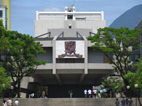Xiaogang Wang, The Chinese University of Hong Kong
Abstract: In recent years, behavior analysis in crowded environments has drawn increasing attentions in the computer vision community because of its wide industrial applications and important scientific values. In video surveillance, automatically detecting abnormal and dangerous behaviors plays an important role in ensuring public safety. In crowd control, recognizing traffic patterns and estimating traffic flows provide valuable information for avoiding congestion. The long-term statistical information from crowd behavior analysis provides guidelines for planning and designing crowded public areas in order to increase their safety and to optimize their traffic capacity. The collective behaviors of crowds show striking analogies with some self-organization phenomena observed in other social processes and other fields such as physics and biology. Therefore, automatic crowd behavior analysis also has scientific values in interdisciplinary fields. This talk will introduce two types of models, hierarchical Bayesian models and agent-based models, based on moving pixels or highly fragmented trajectories to solve this challenge. Hierarchical Bayesian models jointly model simple activities of individual, interactions between individuals, and complex behaviours of the whole scene at different levels. Agent-based models model the process of individuals making decisions of their actions based on the current states. Results on a traffic scene and a train station scene will be shown.
